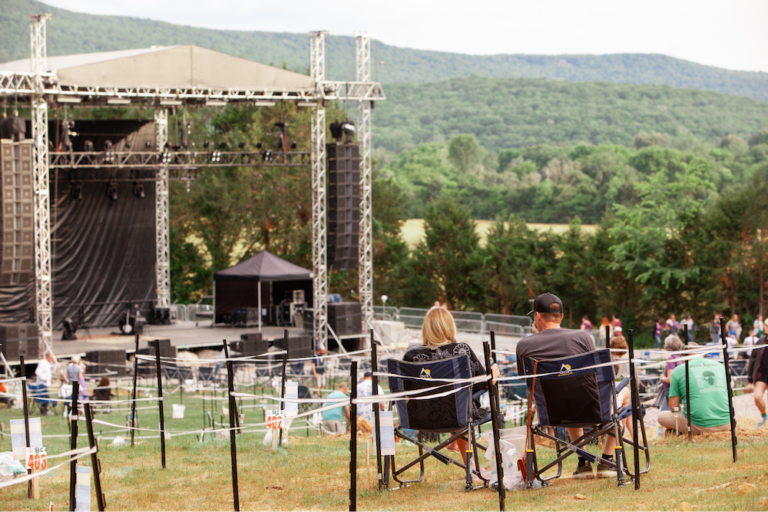Event programs help your guests coordinate and let them know what’s in store so they know when to be where.
While digital programs are super common today, printed event programs help orient attendees quickly without lit-up screens. They’re also a touching gesture, giving your attendees a memento they can keep hold of and allowing you to maximize branding opportunities.
But event programs shouldn’t become an expensive line item on your budget (or a frustrating item on your to-do list). If you use an event program template, you won’t even have to enlist a design master to make the program.
After working on thousands of events, we’ve compiled all our event program best practices into this single comprehensive guide, where we will discuss what to include in your program, where to find templates, and how to customize them for the best attendee experience.

What should an event program look like?
An event program is a resource that provides your attendees with a quick overview of all of your essential event information, with particular reference to any event timings.
At a minimum, an event program should include:
- The event name, date, and location
- The event agenda
- Your organization’s logo and other brand assets
Event programs help attendees:
- Arrive and get seated on time
- Ensure they are in the right place at the right time
- Navigate to and around your event location
They can be digital or physical, and it’s usually good practice to provide both.
By offering a digital version of your event program, whether downloadable or online, you’re allowing guests to find their way around your event in the manner that best suits them (and at no additional cost to you!)
Including a digital event program as well as a print version has a few more benefits:
- Giving attendees the option to save on paper is a great way to be environmentally conscious
- You can issue last-minute updates to the event schedule
- Everyone has a backup program if they lose their physical version
Handing out physical event programs provides a couple of other benefits too:
- Prevents the need for audience members to use their phones during performances, minimizing distractions for performers and other guests
- Caters to a more mature demographic who is less likely to download an app
What’s the point of creating an event program?
A good program concisely communicates the most important event details on a single page.
This allows your guests to find the information they need without wading through emails to find directions or performance times.
Not only is this helpful for your event attendees, but it also makes your life easier by minimizing the number of questions you’ll have to field on the day of your event.
For larger events with multiple stages or more inaccessible locations, event programs make it easier for guests to find their way around — assuming your program includes a map.

What kind of events need a program?
Providing a program is a good practice for any event. However, there are a few event types where attendees will really benefit from a well-designed event program:
- Events with multiple speakers and program items, such as conferences, where audience members might not attend for the entire duration of the program.
- Events with several locations or stages, where attendees will need to move between them or decide between agenda items that are scheduled at the same time.
- Events with locations that are difficult to find or tough to navigate, where an event map would be beneficial.
How do I create an event program?
So, you’re about to create your first event program.Follow these seven steps toward solidifying a memorable experience for your audience.
1. DIY or outsource?
Your first step is to decide: will you create or outsource the creation of the event program?Cost vs time are the biggest factors to consider here.
Remember – you’ll be paying for this service if you hire a freelancer, design house, or event company to create the program.
If you take the do-it-yourself approach, however, you won’t spend any money but will invest your time.
Your own design skills will be important to consider, too: are you able to create a compelling and well-laid-out event program?
Pro tip: If you DIY it, you don’t need to start from scratch! Canva has a ton of great templates to help you get up and running.
It’s a fantastic tool for those of us for whom design is not a strength! Assuming you’ve decided to create the program, choose your template and move on to step two.

2. Start with the basic details
Start simple, and cover the most important details first:
- Name of the event
- Date of the event
- Location of the event
Make these details prominent — they should be easy to find and, for most design layouts, right at the top of the page.
Pro tip: Icons are your best friend — they help your audience navigate the template easily. For instance, a little map icon makes it easy to locate the address.
3. Nail down your agenda and schedule
When you craft your program on a digital device, you can easily forget that the end result will be a physical product (assuming you’re providing a physical version) — once you print it, you can’t go back and change things.
So, you should have your event schedule nailed down before you finalize the program.If you’re struggling with the event scheduling part of the process , check out our guide on event scheduling.
Here are five expert tips for successful event program scheduling:
- Leave some buffer time between event items to prepare for those expected unexpecteds — it’s better to be running ahead of schedule than behind!
- Leave time for attendees to move between stages or rooms
- Keep segments short (between 30-50 minutes) to maintain engagement and keep attendees from getting bored or restless
- Mix up segment types (panel events, speakers, networking sessions) to prevent your event from feeling stale
- Provide your attendees with a recommendation as to when to arrive and be seated, so you can manage the flow of arrivals
4. Provide an easy-to-navigate map
If your event venue is difficult to locate (down a hidden side street or behind another building), it’s a good idea to provide an easy-to-read map to help attendees find you. Even better, consider creating a QR code that links to their navigation app with the exact location of your event, so they can scan it and navigate right to you.
Similarly, you may wish to provide a map for locating different stalls, rooms, or stages within the event venue, like Uprise Events Live Inc. did for their Uprise Fest:

5. Get your branding organized
Now’s the time to bring your brand elements into play.
In many cases, the event program is the first interaction attendees have with your event, so it’s a fantastic opportunity to create a memorable experience and align that experience with the brand you’re working with.
Align your program design with the brand colors, and don’t forget to include the relevant:
- Logo
- Website
- Social handles
- Event hashtags
If you’re a professional event planner, be sure to refer to your client’s style guide, if there is one — this should have instructions on how much space to leave around the logo, what fonts are acceptable, and which colors to apply. Your event program should match all other marketing assets in look and feel.

6. Shout out to your sponsors
Not every event needs sponsors, but if you’ve got some, you should definitely include their logos on your event program, like Touring Mentors Inc. did for their Afrocan Juneteenth event, featured above.
Depending on the size and format of your event program, you can briefly mention their contributions. This will give them extra visibility and keep you in their good graces for future events.
7. Include any other relevant details
Lastly, consider any additional details you want to add to the agenda. None of these are a “must have,” like the items discussed above, but you may wish to include a few if you have space:
- Emergency contact details
- A list of vendors at your events
- Frequently asked questions
- Bios for speakers, VIPs, or guests of honor
- Paid advertisements
- Coupons or vouchers
Consider whether you have the space to add these elements without cluttering your program.
Where to find event program templates to simplify the process
Creating an event program can be time-consuming, but it doesn’t have to be. We’ve created this Eventbrite event program template to kick-start the process and save you the cost of hiring a design expert.
Alternatively, websites like Canva, Venngage, and Adobe offer various templates to help speed up the program creation process. But be aware that, in some cases, you may need to pay for a subscription to use the product.

What makes your event program stand out? Three expert design tips
Creating an event program yourself?
If you don’t have a design background, it can be tough to achieve that professional feel of a program created by an expert designer.
Take note of these three expert tips to get your event program looking like the pros and wow your attendees!
1. Only use high-resolution images
Ever watched a movie from more than 10 years ago and realized just how bad the video quality was compared to today? That’s exactly how your audience will feel if you provide an event program that uses low-resolution images.
Inside tips for keeping images crisp and clear:
- If your image appears blurry, pixelated, distorted, or otherwise low-res on your screen, it probably won’t look good when printed.
- Always start with large images and shrink them down rather than stretching smaller images to fit.

2. Don’t overload the design
Simple, clear, clutter-free designs are almost always better than busy and complex layouts, but this is especially true for anything that will be printed — readers can’t zoom in like they do on a digital device (though some might try to).
The above example from Symposium is perfect. By keeping the design simple and focusing on just one color, they make the program easy to navigate.
If you have a lot of information to display — for instance, if you need to include multiple sponsor logos or provide a map event — consider a double-sided event program or an event centerfold format to prevent your program design from becoming too cluttered.
Pro tips: Useful rules of thumb for event program design:
- Shorten your text boxes to use as few characters as possible. Save longer versions of event descriptions and details for your website or event ticketing page.
- Create a visual content hierarchy: the most important elements should be first and bold.
- Select images wisely, using ones that feature cheerful, smiling faces.

3. Stick to commonly used dimensions
Most event programs are A5-sized, half the size of a standard A4 piece of paper.
This is the perfect size for printed programs because:
- Smaller pieces of paper tend to rustle less, preventing unnecessary noise during presentations.
- An A5 program can easily be folded and stored in an attendee’s pocket.
- Keeping to a smaller format keeps your program focused and concise.
Pro tip: If you need more real estate on the page, opt for a brochure or tri-fold rather than increasing to a plain A4 page.
Use an event program template to get going quickly
An event program is a quick reference, not a comprehensive syllabus. The important information should be concise, and every design element relevant.
The best way to get started quickly is to use a template (you can download ours here) and customize it to your needs.
And if you plan on setting up many events, consider customizing the template with your chosen elements to speed up the program creation process next time.
Want more branding and design tips so you can make better marketing assets for your next event? Check out 10 Tips to Get Started with Event Design.
Eventbrite is your all-in-one event planning, management and marketing platform.
Reach a wider audience and grow attendance with automated email marketing and social media integrations. Monitor the success of your event with a powerful analytics suite. Manage ticketing, build custom event pages, and create automated reminder notifications to keep your event top-of-mind, all with Eventbrite’s expansive event management software platform.






